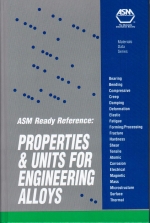Tab Article
This convenient source has definitions, synonyms, abbreviations, and conversion factors for both mechanical and physical properties. For ease of use, all pertinent information, including foreign names and parameters, is grouped onto one single page. You'll also find indexes for foreign abbreviations, names of properties, and complete conversion factors. Ideal for quick, everyday reference, this book was compiled and reviewed by the Materials Properties Database Committee of ASM International.


